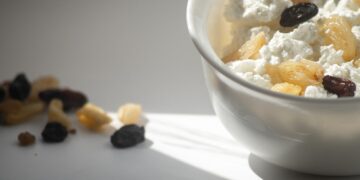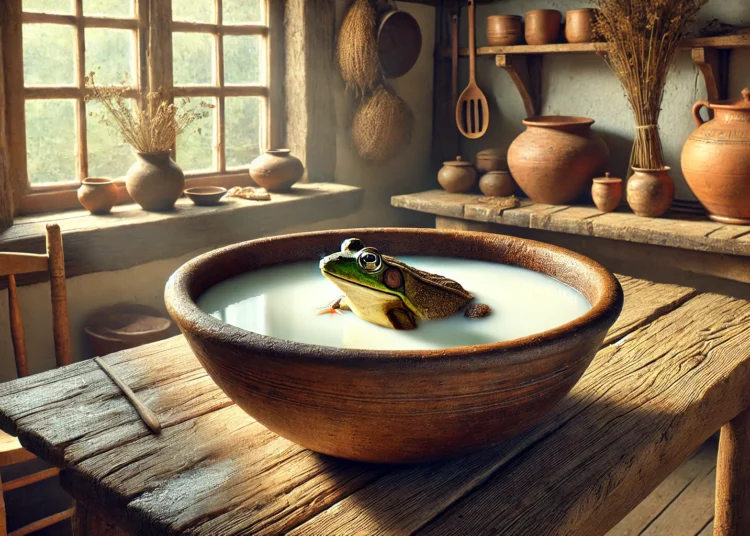Why Did Ancient People Throw Frogs in Milk? Myth Meets Science
Table of Contents
Why did ancient people throw frogs in milk? The answer is both fascinating and strange! A few days ago, I was mindlessly scrolling through Facebook when a post stopped me. It claimed that before the age of refrigerators, ancient milk preservation techniques in places like Russia and Finland involved throwing live frogs into milk to keep it fresh. At first, I laughed, picturing a poor, unsuspecting amphibian as some kind of medieval dairy security guard. I mean, did they really believe that frogs could keep milk cold?
I couldn’t resist diving deeper. Turns out, the story wasn’t about the frog’s cool blood acting as a natural refrigerator (my initial, admittedly clueless theory). It was actually about science—specifically, natural antimicrobials on frog skin that helped combat bacteria. Wait, could this bizarre preservation method actually work?
Let’s explore the fascinating intersection of science, folklore, and human ingenuity. Was this ancient practice truly effective, or just a strange relic of the past? Buckle up, because the truth might just surprise you.

1 The Frog-in-Milk Mystery: A Tale of Ancient Milk Preservation
The Facebook post wasn’t just a joke or some wild urban legend. It turns out there’s actual history—and science—behind this unusual practice. Before refrigeration made it easy to keep milk fresh, people relied on ancient milk preservation methods often out of sheer desperation. In some ancient Russian and Finnish communities, that meant tossing a brown frog, known as Rana temporaria, into a bucket of milk.
Imagine this: You’re in your kitchen, pouring a glass of milk, and your grandmother suggests adding a frog to keep it from spoiling. Pretty wild, right? These days, most of us can’t even fathom putting anything but a lid on our milk jug, let alone a living creature. Yet, for these ancient folks, it was a stroke of ingenuity.
But why frogs? And did it really work, or was it just an old wives’ tale passed down through generations? Let’s start with the historical backdrop. Back then, keeping milk from turning sour was a serious challenge. Without our sleek, temperature-controlled fridges, people had to get creative—or rather, desperate.
While the thought of a frog in your milk might seem gross, science suggests these early dairy keepers weren’t entirely off the mark. Amphibian skin contains antimicrobial peptides, which are natural compounds that help fight bacteria. In fact, a 2013 study identified specific proteins, like Brevinin 1Tb, that could explain why this odd method was surprisingly effective.
Still, it wasn’t just about hard science. Folklore and cultural beliefs often shaped everyday practices. Were the Russians and Finns brilliant microbiologists ahead of their time, or did they simply trust in the supposed magic of frogs? Let’s unpack this mix of fact and fiction to see what’s really going on.
2 The Science Behind Ancient Milk Preservation: Frog Skin Peptides
So, what makes frog skin so special that it was crucial to ancient milk preservation practices? It turns out that frogs, often found in damp, bacteria-rich environments, developed a unique defense system over time. Their skin produces natural antimicrobial peptides, which are small proteins that can kill or inhibit harmful bacteria.
One of the standout proteins discovered in certain frog species is Brevinin 1Tb. This protein and others like it work almost like a built-in bacterial defense shield, helping protect frogs from infections. When ancient people tossed frogs into milk, these antimicrobial compounds likely slowed down bacterial growth, keeping the milk fresh for a bit longer. It sounds strange, but there’s some science to support it.
A study conducted in 2013 confirmed that frog skin secretions contain powerful antibacterial agents. Interestingly, researchers are still looking into how these peptides might be used to develop new, effective antibiotics—a promising area of research, especially in the face of antibiotic resistance.
While our ancestors didn’t understand the molecular details, they knew enough to recognize when something worked. Whether it was through trial and error or sheer luck, frogs became an unexpected part of ancient dairy preservation strategies.

3 Ancient Food Preservation Techniques
Before refrigerators and modern food storage, people had to get creative with ancient milk preservation and other techniques to keep their food from spoiling. Milk, in particular, was a challenge, especially in warmer climates. Ancient communities developed some pretty clever—and sometimes bizarre—methods to make food last longer.
For example, fermentation became a natural solution for preserving dairy. By allowing beneficial bacteria to convert lactose into lactic acid, milk could be turned into yogurt, kefir, or cheese, which were far more shelf-stable. Fermented dairy is still popular worldwide, and we can thank our ancestors for figuring out this trick through sheer necessity.
Another common practice was salt curing, used especially for meat and fish. People would rub salt into food to draw out moisture and create an environment where bacteria struggled to survive. This method was so effective that salted fish became a major trade item in ancient times.
Food preservation in North Africa, particularly in Tunisia, also had its share of creative techniques. The Carthaginians, for instance, mastered olive preservation. They brined or dried olives under the hot sun, storing them in clay jars sealed with a layer of olive oil for extra protection. Sun-drying was another essential method, used for tomatoes, figs, and chili peppers, which were spread out under the scorching North African sun to create long-lasting and flavorful ingredients.
Similarly, in the broader Middle East, pickling became a widespread practice. Vegetables like turnips, cucumbers, and carrots were preserved in brine or vinegar, seasoned with garlic and spices to add flavor while extending their shelf life.
Compared to tossing frogs into milk, these methods may seem more straightforward. Yet, each was a testament to human ingenuity and the constant struggle to keep food fresh before the age of technology.
4 A Lesson in Resilience: The Frog and the Butter Fable
Besides practical techniques like brining or fermenting, traditional societies often passed down knowledge through stories, blending wisdom with a bit of folklore. One tale that stands out—and was even mentioned in a Facebook comment on that intriguing post—is the story of two frogs who fell into a jug of milk.
The story goes like this: Two frogs found themselves trapped in a milk jug, frantically kicking their legs in a desperate attempt to escape. One frog, exhausted and hopeless, gave up and drowned. But the other frog refused to stop kicking, churning the milk beneath it until it eventually turned into butter, giving the frog enough solidity to hop out and survive. It’s a classic fable about perseverance, and one that has been used for generations to teach the importance of never giving up.
When I first read this story, shared anonymously in that Facebook thread, I couldn’t help but smile. It struck me as both whimsical and deeply meaningful. The image of a determined frog kicking for its life, only to transform milk into butter, perfectly encapsulates the idea of resilience. In a way, it reminded me that sometimes the most absurd-sounding solutions—or efforts—can end up saving us.
Now, isn’t it interesting how a story like this connects resilience with milk preservation? It makes you wonder if the tale was inspired by real practices, like the frog-in-milk preservation method. Perhaps these narratives were more than just entertaining stories for children; they were embedded reminders of survival strategies from simpler, yet far more precarious, times.
5 From Frogs to Fridges: How Far We’ve Come
Thinking about ancient food preservation methods like tossing frogs into milk can make us really appreciate the modern convenience of refrigerators. It’s astonishing how much things have changed. Today, we have advanced technology to keep food safe and fresh at precise temperatures. But what did it take to get here?
The invention of the refrigerator in the 19th century revolutionized food storage. It allowed people to keep perishable goods for much longer, reducing waste and improving food safety. Before then, keeping milk from spoiling was a daily challenge. Imagine how life transformed when a simple, reliable way to cool food became available to almost every household.
It’s easy to take our kitchen appliances for granted, but reflecting on how hard our ancestors worked to keep milk and other perishables from spoiling can shift our perspective. They relied on creativity and deep knowledge of natural resources, like sun-drying, fermenting, and yes, even using frog skin to ward off bacteria.
Compared to tossing frogs into a jug of milk, refrigerators seem like absolute miracles of science. And yet, it’s these very stories of trial and error that laid the groundwork for our understanding of food safety. The journey from ancient antimicrobial frog tactics to today’s cutting-edge cooling technology reminds us of the ingenuity of the past and the leaps we’ve made since then.
6 Debunking or Verifying: Where Does the Science Stand?
So, was the ancient practice of tossing frogs into milk effective, or has it been overhyped? Modern research sheds some light on the idea. Frog skin is known to secrete a variety of antimicrobial peptides, which act as a natural defense against bacteria. These compounds work by disrupting bacterial cell membranes, making them highly effective at killing or neutralizing harmful pathogens.
For example, studies have analyzed the antimicrobial activity of peptides from the Russian Brown frog, which was traditionally used to preserve milk. Scientists discovered over 76 different peptides with significant antibacterial effects, some even performing on par with prescription antibiotics in lab settings. These peptides have shown potential in fighting bacteria like Salmonella and Staphylococcus, providing some scientific backing to the old preservation method. However, how well this method worked outside of controlled conditions is still up for debate. Variables like environmental factors and peptide concentration would have played a huge role in its real-world success.
Interestingly, the discovery of these potent antimicrobial peptides has opened doors for medical research. Scientists are exploring their potential as new antibiotic agents, particularly in the battle against antibiotic-resistant bacteria. While the ancient milk preservation technique may not have been perfect, it was a fascinating precursor to understanding the antimicrobial properties found in nature.
Does the Frog Survive in the Milk?
One question that lingered in my mind while researching this ancient practice was, What happens to the frog? Did it simply tread milk endlessly, or did it eventually drown, exhausted from its struggle? The mental image of a frog swimming tirelessly in a jug of milk is both bizarre and oddly concerning. If the frog did drown, would that compromise the milk’s freshness, or did the antimicrobial properties of its skin somehow continue working after death?
There’s another unsettling thought: If the frog was covered in dirt or bacteria from its river habitat, how effective was this preservation method, really? People of the time might not have worried much about hygiene in the way we do now, but it raises the question of whether the benefits of antimicrobial peptides outweighed the risks of possible contamination. Maybe, for those desperate to keep milk fresh, a little leap of faith—and tolerance for the unexpected—was just part of the deal.
These questions don’t have straightforward answers, but they certainly add a human dimension to this curious preservation method. Our ancestors, experimenting with what they had, must have weighed the risks and benefits as best they could, trusting nature to provide a solution where technology had yet to catch up.
Read here about my year in Shanghai as an expat
7 Reflecting on Gratitude for Modern Conveniences
When I think about how far we’ve come, I can’t help but feel immense gratitude. Today, we have refrigerators, dishwashers, and so many other appliances that make our daily lives so much easier. But just a few generations ago, life looked very different. My grandmother and her mother before her had to work tirelessly to keep their families fed and cared for, even through times of war and incredible hardship.
Back then, women didn’t have the option to take breaks or choose when to stop having children. Pregnancy often came one after another, and life’s demands never slowed down. Where I come from, large extended families typically lived together, meaning that even when a man got married, his new wife would move in with his parents. The young wives took on the role of caring not only for their own children but also for their in-laws. Baking bread from scratch, cooking big meals, and tending to the needs of a bustling household—all without modern conveniences—was just part of daily survival.
Thinking about this, I’m humbled by the strength and resilience of those women. The comforts we enjoy today are luxuries they couldn’t have imagined. It’s a reminder of how fortunate we are, but also a way to honor the generations of women who made the most of what they had, often sacrificing their own comfort and dreams for the sake of their families.
8 Reflection and Takeaway
Reflecting on ancient milk preservation and the ways our ancestors kept milk and other perishable foods fresh can make us appreciate just how far we’ve come with modern technology. From the bizarre yet effective use of frog skin’s natural antimicrobials to the widespread use of pickling and fermenting, human ingenuity has always found a way to adapt and survive.
The story of the frog in the milk jug isn’t just a quirky historical tidbit—it’s a testament to the resourcefulness of people who made do with what nature provided. And while today we rely on sleek, stainless-steel refrigerators to keep our food fresh, it’s fascinating to think about the lessons our ancestors learned from trial and error. Some of those lessons even hold relevance today, especially as scientists explore nature’s antibacterial compounds for potential new medical treatments.
So, what other bizarre yet brilliant techniques did our ancestors use to survive? The past is full of wisdom, and sometimes the strangest ideas turn out to have a basis in science. As we think about these ancient practices, maybe we can appreciate the strange and wonderful journey from frogs in milk to the refrigerators humming quietly in our kitchens today.
What are your thoughts on these ancient preservation methods? Have you heard of other unconventional techniques that made you marvel at human creativity? Feel free to share your stories or reflections!


































